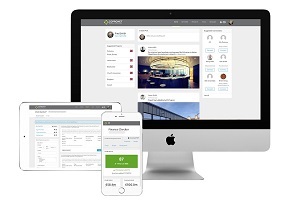Copronet

|
Companies in the construction industry are facing increasing pressure to maintain a competitive advantage, while minimising costs and harnessing new technologies. In a heavily saturated market, technology adoption is surprisingly low. In fact, construction is the second least digitised industry in the world (after agriculture). Companies – both large and small (from contractors, to consultants, to trades, and even clients) – are constantly seeking ways to enhance productivity and profitability, and most importantly, to connect with the people and skills they most need. That’s why any new technology has to earn its keep. It needs to be easy to use, demonstrate measurable value and show positive return on investment (ROI).
Copronet (formerly called TenderSpace – an RICS Tech Affiliate) launced on Monday 4th February 2019, and will give the construction industry a new way to connect, collaborate and grow. The no/low cost online platform has been designed to transform the way the industry works, offering a single hub where people, tools and projects can come together.
Copronet is aimed at everyone in construction – trades, contractors, project managers, clients, architects, specialists, building firms and enterprise-level businesses. At its heart is a network that allows members to find and connect with relevant professionals from all parts of the industry.
It also offers a new way to find work, with over 150,000 projects listed. The suite of built-in tools allows users to access project management, time tracking, credit rating reports, and more, within the site. The result is a standalone platform from which to do business, run projects and showcase work.
Built by the construction industry for the construction industry, Copronet’s creators, Emma and David Stapleton, were inspired by their own experiences within the sector, including struggles to find specialists, a lack of transparency, and the shortcomings and frustrations of existing networking sites.
Emma said: “We felt that a digital hub was missing from our sector and we wanted to provide this. We created Copronet to make the construction industry fairer, faster and more efficient.”
David said: “A big part of this was making sure Copronet was accessible to everyone. We believe everyone should have access to the best technology without having to worry about the cost, so there will always be a free plan for Copronet. And our pricing for other plans will always be affordable.”
A key feature is that each person’s network is kept private. No one else can see their connections. This is particularly important in construction where professionals spend years building up their little ‘black book’.
Business risk is always an issue in construction, with even big names running into difficulty. So Pro Plan users will appreciate the four credit checks per month and the alerts that warn of possible business risks relating to companies they’re involved with.
For more information see: https://www.copronet.com/
[edit] Related articles on Designing Buildings Wiki
Featured articles and news
RTPI leader to become new CIOB Chief Executive Officer
Dr Victoria Hills MRTPI, FICE to take over after Caroline Gumble’s departure.
Social and affordable housing, a long term plan for delivery
The “Delivering a Decade of Renewal for Social and Affordable Housing” strategy sets out future path.
A change to adoptive architecture
Effects of global weather warming on architectural detailing, material choice and human interaction.
The proposed publicly owned and backed subsidiary of Homes England, to facilitate new homes.
How big is the problem and what can we do to mitigate the effects?
Overheating guidance and tools for building designers
A number of cool guides to help with the heat.
The UK's Modern Industrial Strategy: A 10 year plan
Previous consultation criticism, current key elements and general support with some persisting reservations.
Building Safety Regulator reforms
New roles, new staff and a new fast track service pave the way for a single construction regulator.
Architectural Technologist CPDs and Communications
CIAT CPD… and how you can do it!
Cooling centres and cool spaces
Managing extreme heat in cities by directing the public to places for heat stress relief and water sources.
Winter gardens: A brief history and warm variations
Extending the season with glass in different forms and terms.
Restoring Great Yarmouth's Winter Gardens
Transforming one of the least sustainable constructions imaginable.
Construction Skills Mission Board launch sector drive
Newly formed government and industry collaboration set strategy for recruiting an additional 100,000 construction workers a year.
New Architects Code comes into effect in September 2025
ARB Architects Code of Conduct and Practice available with ongoing consultation regarding guidance.
Welsh Skills Body (Medr) launches ambitious plan
The new skills body brings together funding and regulation of tertiary education and research for the devolved nation.
Paul Gandy FCIOB announced as next CIOB President
Former Tilbury Douglas CEO takes helm.
UK Infrastructure: A 10 Year Strategy. In brief with reactions
With the National Infrastructure and Service Transformation Authority (NISTA).






















